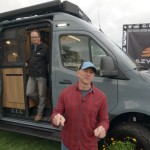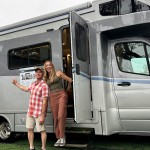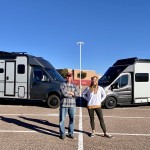This post may contain affiliate links.
Stef and I recently attended Advanced RV‘s “Advanced Fest” in Ohio. We were there mainly to lead exercise sessions and to give a seminar on healthy RVing, but also had fun attending other sessions and nerding-out (as Stef says) with fellow RV enthusiasts. As the sessions were winding down, we were able to grab CEO Mike Neundorfer for a quick video about what new developments have been going on in Advanced RV’s Class Bs over the past year. Check it out:
To those of you with recent Advanced RVs, or those of you who were there, you probably already know all of this. But for those of you who weren’t, we got updates from Mike on three main topics:
- Continued development of their lithium battery setup and control systems: Advanced RV is putting 800 amp-hours of lithium batteries in their RVs now, and doing away with the traditional generator. Making the best use of lithium batteries requires some special attention, and Mike filled us in on some of what Advanced RV is doing in this area. Specifically, we discussed temperature regulation for charging, and the control systems they use to monitor their batteries (every cell, temperature and voltage, 100% of the time), and also limit depth of discharge (factory-set at 80%, but owners can adjust this). Properly managing a lithium battery setup is a whole field unto itself, and these are just some of the things Advanced RV is doing to make the technology accessible to RVers.
- The Smart Plug: A crossover product from the yachting industry, the Smart Plug is now being fitted to Advanced RVs. A plug might seem a simple thing, but this one allows increased safety, easier connecting and disconnecting, and thermal runaway protection. That’s doing a lot for a part most of us take for granted. And, of course, now I want one.
- Natural Latex Foam: Stef and I are huge fans of natural latex foam. This came about when a discount-store “memory foam” mattress pad tried to kill me with its off-gassing. Ever since then, we’ve bought no more of the stuff. We’re excited to see that Advanced RV is now offering real natural latex foam as an option for its customers in beds and seating. Hurrah!
There were a lot more things discussed at Advanced Fest (4×4 Sprinters, articulating beds, wheel options, etc). And I’m sure we can count on them to continue to explore new technologies for RVers in the coming years as well.
Thanks for watching!











Hello,
Thank you for your wonderful videos. Your new Video on Winnebago’s lithium battery installed in van was great. Please do comparison with Advanced RV batteries. So new buyers have some idea on what’s cutting edge technology they should go for. Safety and rigorously tested product should be safest choice for new consumers. Again, thank you for those beautiful videos from Europe. Your channel is my fav channel past my bed time.
James,
I’m glad someone is researching lithium battery use for rv’s. Right now the technology seems very clumsy with lots of components tied together with hundreds of feet of wire and connectors. Currently there seem to be lots of limiting items here for practical use (charging requirements, weight, and space considerations) as well as limited on line usage of the battery “bank” under real world applications. In other words- the generator is still the king for convenience and practicality. I’m watching this lithium battery concept with hope but I’m skeptical that it will make it’s way into large class A rv’s any time soon.
The plug connector doesn’t really peak my interest either. It seems to be a gimmick someone is trying to use to solve a percieved problem that doesn’t exist. If regular maint. is one of your rv’ing habits then you will probably never have power cord electrical problems. If you look at the rv forums much you’ll notice the absence of threads having reference to cord problems. (Actually one of the most frequent things talked about is driving off without disconnecting it).
When you really look at these things- sometimes it seems a lot of “must haves” are just devices and methods designed to protect people from themselves. Sorry I’m sounding like the “grinch” of today’s tech but if you stand outside yourself for a minute and look at things logically you might come to the same conclusion. Anyway, thank you for taking so much time to put up another interesting post.
Glad you find our posts useful!
Honestly, I’ve never had a plug mishap either. And the Advanced RV owners don’t strike me as the kind to let a simple routine maintenance item get by them. They all seem to know what’s going on with their RVs more than most.
I suspect it had more to do with being able to hookup without looking and thereby hide the connection. Advanced RV puts very few things on the sides of their RVs to give them away. It’s a *very clean* look, even if you’re not into “stealth”.
Thanks for the video, I appreciate all the effort you’re putting into this site. I was wondering if you’d heard anything about RV manufacturers considering an electric drivetrain instead of gas/diesel? It would make so much sense considering how many campgrounds have an electric hookup. Just charge overnight and the next morning you have a full ‘tank’. I’d certainly pay an upfront premium to get myself an electric RV over a gas/diesel one.
That’s an interesting idea, but I haven’t heard of any manufacturer looking into it yet. Range might be a problem, especially with the weight of a motorhome. And then, I’m pretty sure campgrounds would start metering your electricity. Solar would also have to be better than today to allow you to boondock much – even if it was cloudy…
It will probably happen some day, but I don’t think the technology is quite there yet.
Thanks for getting back to me! How much range do most people need in a day? People said the same thing about cars like the Tesla Model S… Plus the weight of the batteries would be less of an issue on a large vehicle like that – more battery=more range. Solar might be enough to give sufficient charge to get you from a boondock site to a plug. Even if the electricity were metered, it’d still be far cheaper per mile than any liquid fuel. An electric motor is far simpler than a combustion engine, so maintenance would be cheaper and easier… There are so many advantages – the problems you pointed out seem to be eminently soluble. I hope it does take off, it just seems to make sense to me. Thanks again for taking the time to reply, I appreciate it.
Well, as far as range, Stef and I have been known to cover over 600 miles in a day… 🙂
The trick would be to put a small gas/diesel engine in front to charge the batteries if needed. Like a plugin hybrid.
(Btw, would it be possible to set up some rss feeds to make it easier to follow yoru site? thx 🙂
You can subscribe to our site at https://www.thefitrv.com/feed.
Or, if you’d rather get it through email, you can sign up for our “one email per week with new posts” newsletter.
(We really should do more with our newsletter, but we don’t want to bug people with too much email.)
Henry, that’s an interesting idea but will probably remain impractical for a lot longer than you might expect.
Where the Tesla Model S has a drag area of 6.2 sq ft, a raw Mercedes Sprinter has almost 3 times that at 17 sq ft. Let’s go with 2.7x drag for a Sprinter vs the Model S.
A Tesla Model S on a 50 amp 220 circuit (which rules out many campground sites which only have 30 amp 110) only recharges 29 miles of range per hour. Assuming that an electric RV requires 2.7x the energy per mile (given a probable 2x curb weight, and much worse in drag coefficient), a 50 amp would only provide 11 miles of range per hour of charging. The optimal mix for this is 3:30 drive time (210 miles @ 60mph) followed by 19 hours of charging to replace that energy.
30 amp 110 circuits only give a Tesla Model S 8 miles per hour of charging – let’s say 3 miles for the RV. The optimal mix is then 1:06 drive time (66 miles @ 60 mph) followed by 22:00 of charging.
In all likelihood my 2.7x guess is wildly optimistic. The current Tesla Model S has an 85 kWh battery to give it a 270 mile range. The best Sprinter RV mileage I’ve heard of was 22 mpg, and a gallon of diesel is equivalent to 40 kWh of energy. So the Sprinter would use 12.3 gallons of diesel to drive 270 miles, or 490 kWh of energy. The energy requirements of the Sprinter could be more like 5.7x rather than the 2.7x I used above.
So without a fundamental change in electric drive efficiency (and I think we’re up against physics here) there’s just no way to give an electric drive RV a useful range without tripling the charging amps.
Appreciate the inputs, Chuck!
I’d agree that you’re being WAY too optimistic on the drag of a typical RV. Think “brick”. lol.